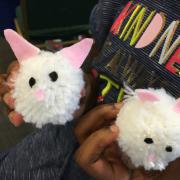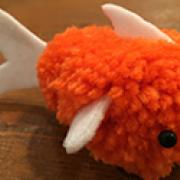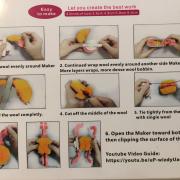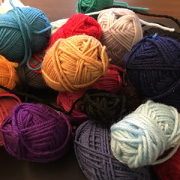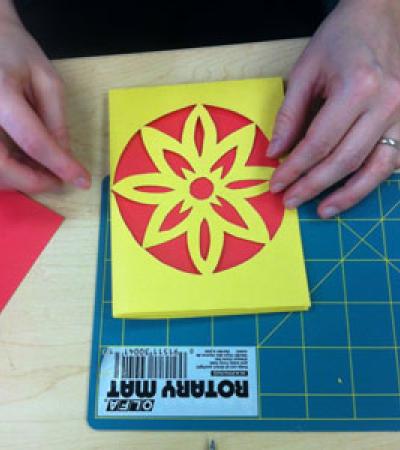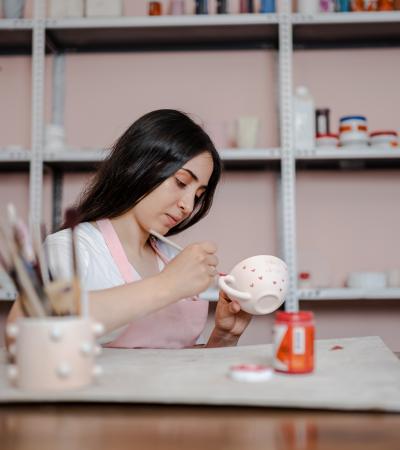In the Pom-Pom Animals class, a child and parent/guardian learned to make pom-poms with a maker tool. Then they shaped and decorated the pom-pom to look like an animal or monster. Participants decorated the pom-poms with markers, felt shapes and googly eyes.
Advanced Planning
Pom-Pom Animals was part of a sequence of seven classes called Hands On! Fridays, and was designed for school-aged children (ages 5-12) and parents/caregivers to work together on an activity. These STEAM classes alternated weeks between art and technology. The series was planned four months before Summer Reading began, but the actual mechanics of the Pom-Pom Animals class were determined about four weeks in advance.
Hands On! Fridays was a weekly summer version of our monthly class, Tinker Tuesdays. Both series were planned and conducted by our Adult Services team. The classes are a sneaky way to engage busy parents in lifelong learning and market library materials and services to them. The parents think they are doing something for their children (and they are), but the classes are really to engage adults with the library.
The programs are designed to be a bit harder than your average craft/activity, so the child genuinely needs to work collaboratively with the adult to complete the task. The goals for the class were to create an additional STEAM educational opportunity for children, which serves the city’s vision plan, and to deepen the connections of adult patrons to the library and its resources.
Marketing
We use our normal marketing strategies for Tinker Tuesdays and Hands On! Fridays. Announcements appear on the library’s online calendar of events, in the e-newsletter, in the youth services events brochure and on social media.
We have never had a problem with attendance for any of these classes. When there is a limited supply of materials, we require sign-up. However, we try to avoid limiting attendance.
Budgeting
The budget for Pom-Pom Animals was about $100. I purchased six pom-pom maker sets. The sets were $7 each, and each set had four makers of different sizes.
I spent too much on yarn ($60), but I made the right decision about the kind of yarn. I bought bundles with lots of small skeins in various colors. By having the small skeins, we didn’t have to cut off yarn from a big skein for each person. We just handed someone a whole skein in the color of their choice. We ran out of black really fast. People who made big pom-poms used their entire skein, but some skeins were returned half-used. I also bought a multi-colored pack of felt for embellishments. We had googly eyes already on hand.
We plan to do another pom-pom program in December and make holiday decorations. I’m going to buy a little extra yarn in holiday colors. One new expense will be good scissors. We used our existing craft scissors, but they were just too dull. It really slows down the process when you have trouble cutting the yarn. The new sharp craft scissors will be about $64 for eight pairs.
Day-of-event Activity
Two staff members ran the event. We specifically structure the Tinker Tuesday and Hands On! Friday events so that the parent and child are figuring out how to do the activity themselves. But this one took a little bit of coaching/troubleshooting, so we needed two staffers. We set up tables with craft supplies and prepared instructions on each. (See instructions under Photo Slideshow at right.)
I gave a brief introduction of the activity and a few pointers, then we let them loose. The only unexpected thing that happened was a family that showed up 10 minutes before the end of the program and insisted on doing the craft. Amazingly, they finished.
Program Execution
For the Pom-Pom Animals class, specifically, we had 42 attendees (13 adults and 29 children). The feedback during the program was very positive, so we decided to do another pom-pom class in December.
We definitely achieved our goal of engaging the parents. They were just as proud of the finished product as the kids, because they weren’t in the back of the room on their phones. Also, one parent asked that we start circulating the pom-pom maker kit, which we will start doing after the class in December.
We started Tinker Tuesday as an experiment to see if parents would bring their children and truly participate. I have been highly pleased with the consistent attendance to the classes as well as the engagement level of the parents. We have not done any formal evaluation. We have only collected anecdotal information from the participants and librarians.
Advice
I highly encourage hosting a hands-on STEAM class that gets the parent involved in the activity as a collaborator. We now have a group of regulars that come to the classes and just love it.
The trick is to advertise in class announcements that the activity is for both the child and parent. Explain this again at the beginning of each class that this activity is meant to be collaborative. You and your child are experimenting and learning together. For every class, we leave instructions on the table and leave them to figure everything out. We only intervene if they get stuck.
Supporting Materials
- Feedback (Coming Soon!)
- Programming Librarian Facebook Group

